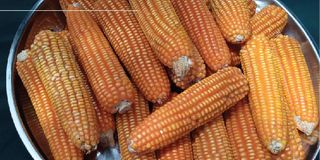Orange fleshed maize a big deal

Orange fleshed maize on display at Naro. The new variety is rich in nutrients. PHOTO/LOMINDA AFEDRARU
What you need to know:
- Farmers who use equipment such as planters are encouraged to plant when the soil is slightly dry to avoid clogging of the planter to the soil and a fine seed bed is required.
In recent years, agricultural scientists in East Africa researching and breeding various crops have been breeding hybrid varieties to address a number of challenges faced by the farmers.
In the case of maize, there are diseases such as Maize Lethal Necrosis (MLN) coupled with the fall army worm which has been ravaging farmers’ fields in most parts of Uganda and western Kenya where maize is grown most.
Other challenges include the effects of drought, pests such as stem borer and Striga.
However scientists have of late began breeding orange fleshed maize to address the challenge of nutrition incorporating beta carotene, vitamin A, Iron and zinc, among others, directly in the crops.
Agronomy
Dr Charles Lwanga Kasozi, the principal investigator of the programme at the National Crop Resources Research Institute (NaCRRI) in Namulonge explains the agronomy of the new maize variety. The orange maize is a hybrid variety and white hybrid varieties where used as checks during the trial, this therefore means farmers must purchase seed every planting season to maintain the high yield.
On average the yield showed between six to eight tonnes per hectare and when grown under optimum conditions, it is tolerant to pests, diseases and drought.
Planting
Dr Lwanga notes that farmers growing the orange fleshed maize variety will follow the usual practices for growing any other hybrid maize.
He advises farmers to always engage in timely land preparations before the rain season starts for timely planting.
The first rainy season for areas along Lake Victoria basin, eastern Uganda, mid-western and the southern parts of the country starts at the end of this month. Other areas mainly in the northern region experience major rains in the month of July and it is a major season for farmers growing the crop.
Farmers who use equipment such as planters are encouraged to plant when the soil is slightly dry to avoid clogging of the planter to the soil and a fine seed bed is required.
It is important to apply one bag of 50 kilogrammes of DAP fertiliser on one acre during planting.
When the plant has reached one and half feet, farmers can apply urea fertiliser of 50 kilogrammes per acre.
Spacing and weeding
The spacing is 75cm between rows and 25cm by 25cmform one plant to another. It is important to keep the garden weed-free either by weeding using hoe or using selective types of herbicide which do not affect the plant when the field is sprayed.
Dr Lwanga says effective weed control is a prerequisite for high maize yields. Early control of weeds recommended at two to three weeks after planting is extremely important because the root system of the plant develops at this stage and some weeds secrete chemical inhibitors which limit plant growth.
It is also recommended to weed five to six weeks after planting to prevent weeds from adversely affecting the quality of the crop. Control of weeds can be manually done using hand hoes, hand pulling, mechanical weeders or by chemical means.
There can be severe effects of weeds because they reduce yield by competing with the maize crop for minerals, light and moisture, especially during the early stages of crop growth.
Some weeds are alternative hosts of pests and diseases, some are parasitic and poisonous to maize, a case in point is Striga weeds and a thick growth of weeds in maize makes harvesting difficult. It is important to allow the maize to grow to full maturity before harvesting.
Pets and diseases
The pests may attack in the field but mostly at storage. During storage, maize like other grains is attacked by insects, moulds and rodents such as squirrels and rats. At field level it is mainly the ball worm which is a major pest but resistant Drought Tego Wema varieties have been developed to curb this.
Pests form the major problem in a storage, especially where good storage management practices are not adhered to and these pets include Sitophilus spp., Sitotroga cerealella, Rhizopertha dominica, Prostephanus truncates, Callosobruchus maculates, Pyralid moths, termites, mites and ants among others.
Maize Lethal Ncerosis is a major disease but is being curbed by developing resistant varieties.
Post-harvest handling
Farmers are expected to allow the maize to dry in the field to a moisture content of 20 per cent and thereafter harvest it and keep in cribs for further drying. The required moisture content is 13 per cent. Farmers are advised to store the grains in shield bags and placed on a raised facility.
[email protected]




